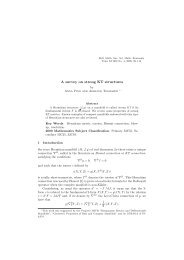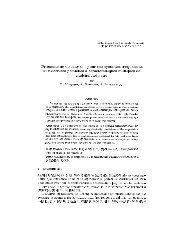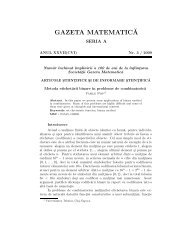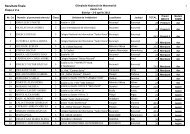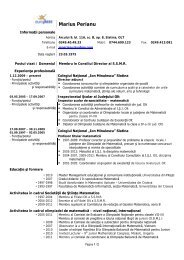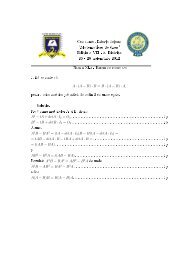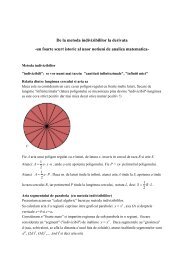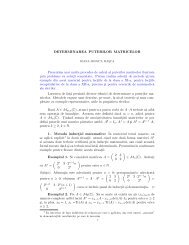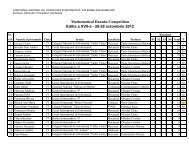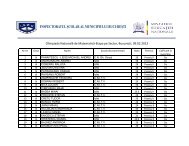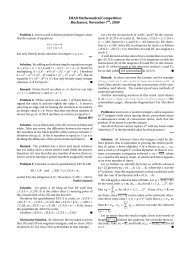On the Annihilation of local homology modules - SSMR
On the Annihilation of local homology modules - SSMR
On the Annihilation of local homology modules - SSMR
You also want an ePaper? Increase the reach of your titles
YUMPU automatically turns print PDFs into web optimized ePapers that Google loves.
<strong>On</strong> <strong>the</strong> <strong>Annihilation</strong> <strong>of</strong> <strong>local</strong> <strong>homology</strong> <strong>modules</strong> 65A sequence <strong>of</strong> elements x 1 , . . . , x n in R is said to be an A-coregular sequence(see [8, Definition 3.1]) if 0 : A (x 1 , . . . , x n ) ≠ 0 andx0 : A (x 1 , . . . , x i−1 ) −→i0 :A (x 1 , . . . , x i−1 ) is surjective for i = 1, 2, . . . , n. Wedenote by width(a, A) <strong>the</strong> supremum <strong>of</strong> <strong>the</strong> lengths <strong>of</strong> all maximal A-coregularsequences in <strong>the</strong> ideal a.Corollary 2.2. Let a be an ideal <strong>of</strong> R such that 0 : A a ≠ 0. Then width(a, A) =inf{n : Tor R i (R/a, Hj a (A)) ≠ 0 for some non-negative integers i, j with i+j = n}.Pro<strong>of</strong>: We denote by B <strong>the</strong> set in <strong>the</strong> above equality. In view <strong>of</strong> [3, Theorem4.11] it follows that width(a, A) ≤ inf B. <strong>On</strong> <strong>the</strong> o<strong>the</strong>r hand, by Theorem 2.1 and[8, Theorem 3.9] we have inf B ≤ width(a, A). This finishes <strong>the</strong> pro<strong>of</strong>.Corollary 2.3. Let a ⊆ b be two ideals <strong>of</strong> R. Then, for each non-negative integern, ⊓ n i=0 Ann(Ha i (A)) ⊆ ∩ t≥1 ∩ n i=0 Ann(TorR i (R/b t , A)).Pro<strong>of</strong>: Let t be a positive integer. Then a t ⊆ b t . Hence, for each non-negativeinteger m, it follows from Theorem 2.1 and [2, Remark 2.1(ii)] that⊓ i+j=m Ann Tor R i (R/b t , Hj a(A)) ⊆ Ann(TorR m(R/b t , A)). Since <strong>the</strong> Tor functorsare linear, <strong>the</strong> result now follows.Theorem 2.4. Let a ⊆ b be two ideals <strong>of</strong> R, and n a non-negative integer suchthat Hi a(A) is Artinian for all i < n. Then a ⊆ Rad(Ann(Hb i (A))) for all i < n.Pro<strong>of</strong>: By [2, Proposition 4.7], <strong>the</strong>re exists a positive integer m such thata m Hi a(A) = 0 for all i < n. Put l := mn. Then al ⊆ ⊓ n−1i=0 Ann(Ha i (A)).Thus, by Corollary 2.3 a l ⊆ ∩ n−1i=0 Ann(TorR i (R/b t , A)) for all t ∈ N. Thereforea l Hi b(A) = 0 for all i < n and so a ⊆ Rad(Ann(Hb i (A))) for all i < n, as required.We prove <strong>the</strong> following <strong>the</strong>orem by similar techniques that used in [10, Theorem3].Theorem 2.5. Let n be a non-negative integer such that a = (x 1 , . . . , x n ). Ifc = ∩ t≥1 ∩ n i=0 Ann(TorR i (R/a t , A)), <strong>the</strong>n c k ⊆ ∩ n−1i=0 Ann(Ha i (A)) where k = (n [ n 2 ]).




